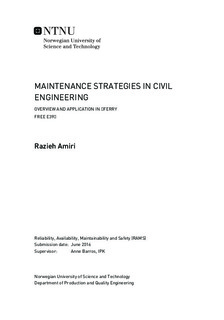MAINTENANCE STRATEGIES IN CIVIL ENGINEERING - OVERVIEW AND APPLICATION IN FERRY FREE E39
Master thesis
Permanent lenke
http://hdl.handle.net/11250/2403654Utgivelsesdato
2016Metadata
Vis full innførselSamlinger
Sammendrag
This report focuses on the maintenance activities in civil engineering considering the used case Bjørnafjorden as a part of Ferry Free E39 project. Civil engineering is one of the oldest sectors in engineering, and its importance has been increasing in the last decades because of the advancement in modern civilization. Furthermore, maintenance activities have always been an integral part of civil industries. Especially in the large scale projects like Bjørnafjorden , the role of maintenance will be more crucial and vital due to the fact that even a slight fault in a small component can lead to a loss of millions of money. Based on this purpose, first classical and Risk-Based Maintenance (RBM) methods are presented as the maintenance strategies that are used in civil engineering. Classical maintenance strategies, which are preventive-policy based, are categorized as on-demand and periodical types. The maintenance intervals used in these strategies are claimed based on the reliability-based method considering the influencing factors on the structures. Furthermore, Risk-Based Maintenance (RBM) method, as another maintenance strategy, assesses the maintenance intervals considering the level of risks in the structures. The risk value in this method can be claimed based on the experts judgments and condition assessment data.Further, Bjørnafjorden is a part of Ferry Free E39 project. The unique characteristics of this fjord make this project very huge. SVV (Statens Vegvesen) suggested three concepts as the possible solutions to this project: 1) Floating bridge (FB), 2) suspension bridge supported by tension leg platform (TLP), and 3) submerged floating tunnel bridge (SFTB). In order to assess the maintenance performance in these three concepts, qualitative comparison and sustainability-based methods are presented as the two maintenance strategies that can be used in the new bridge concepts. The main criteria in qualitative comparison methods are introduced as maintainability and maintenance-related risks. Further, in sustainability-based method, the maintenance performance can be analyzed by the sustainability score. The presented strategies can provide SVV with some inputs to make decision and choose an appropriate concept regarding the maintenance.
